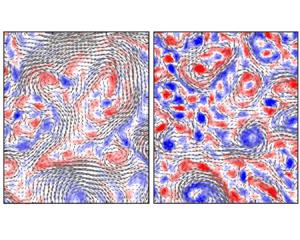No CrossRef data available.
Published online by Cambridge University Press: 02 October 2024

An experimental investigation is conducted to study the flow patterns, spectral properties and energy fluxes in thin-layer turbulence with varying system sizes and damping rates. It is found that although a system-size vortex (an indicator of spectral condensation) occurs for small system sizes and does not for large ones, the spectra for different system sizes consistently exhibit a scaling close to  $k^{-3}$ in inverse cascade (another indicator of spectral condensation). On the other hand, under a fixed system size larger than the friction-dominated length scale, the energy spectrum in the inverse cascade range changes from
$k^{-3}$ in inverse cascade (another indicator of spectral condensation). On the other hand, under a fixed system size larger than the friction-dominated length scale, the energy spectrum in the inverse cascade range changes from  $k^{-3}$ to
$k^{-3}$ to  $k^{-5/3}$ as the damping rate increases, suggesting that the friction-dominated length scale may not be a suitable parameter for predicting spectral transition. At lower damping rates and large system sizes, turbulent structures grow larger via inverse cascade, manifesting as long streamers, and the small-scale vortices are suppressed. This suppression leads to a reduction of energy flux at intermediate scales and a change in the spectral shape. The dimensionless Taylor microscale is found to exhibit a monotonic dependence on the damping rate. With the reduction in the damping rate, the Taylor microscale increases to become comparable with the forcing scale, and the spectrum in inverse cascade transits to a steeper scaling,
$k^{-5/3}$ as the damping rate increases, suggesting that the friction-dominated length scale may not be a suitable parameter for predicting spectral transition. At lower damping rates and large system sizes, turbulent structures grow larger via inverse cascade, manifesting as long streamers, and the small-scale vortices are suppressed. This suppression leads to a reduction of energy flux at intermediate scales and a change in the spectral shape. The dimensionless Taylor microscale is found to exhibit a monotonic dependence on the damping rate. With the reduction in the damping rate, the Taylor microscale increases to become comparable with the forcing scale, and the spectrum in inverse cascade transits to a steeper scaling,  $k^{-3}$, indicating that the dimensionless Taylor microscale may be used as a diagnostic parameter for spectral transition.
$k^{-3}$, indicating that the dimensionless Taylor microscale may be used as a diagnostic parameter for spectral transition.